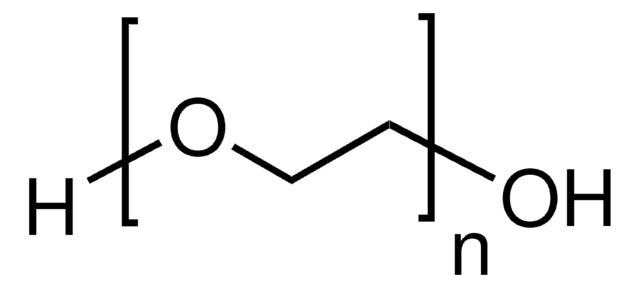202509
Poly(ethylene glycol) methyl ether
average Mn 2,000, methoxy, hydroxyl
Synonyme(s) :
Polyethylene glycol monomethyl ether
About This Item
Produits recommandés
Product Name
Poly(ethylene glycol) methyl ether, average Mn ~2,000
Densité de vapeur
>1 (vs air)
Niveau de qualité
Pression de vapeur
0.05 mmHg ( 20 °C)
Forme
flakes (or pellets)
Poids mol.
average Mn ~2,000
Viscosité
54.6 cSt(210 °F)(lit.)
Température de transition
Tm 52 °C
Groupe fonctionnel
hydroxyl
Chaîne SMILES
O(CCO)C
InChI
1S/C3H8O2/c1-5-3-2-4/h4H,2-3H2,1H3
Clé InChI
XNWFRZJHXBZDAG-UHFFFAOYSA-N
Vous recherchez des produits similaires ? Visite Guide de comparaison des produits
Catégories apparentées
Description générale
Application
It can be used as a pore-forming agent in the preparation of ultrafiltration membranes which are used in the removal of macromolecules.
It can also be used as a starting material in the preparation of a biodegradable amphiphilic copolymer of poly(L-alanine) with mPEG.
Caractéristiques et avantages
Code de la classe de stockage
11 - Combustible Solids
Classe de danger pour l'eau (WGK)
WGK 1
Point d'éclair (°F)
359.6 °F - closed cup
Point d'éclair (°C)
182 °C - closed cup
Équipement de protection individuelle
Eyeshields, Gloves
Faites votre choix parmi les versions les plus récentes :
Déjà en possession de ce produit ?
Retrouvez la documentation relative aux produits que vous avez récemment achetés dans la Bibliothèque de documents.
Les clients ont également consulté
Notre équipe de scientifiques dispose d'une expérience dans tous les secteurs de la recherche, notamment en sciences de la vie, science des matériaux, synthèse chimique, chromatographie, analyse et dans de nombreux autres domaines..
Contacter notre Service technique


